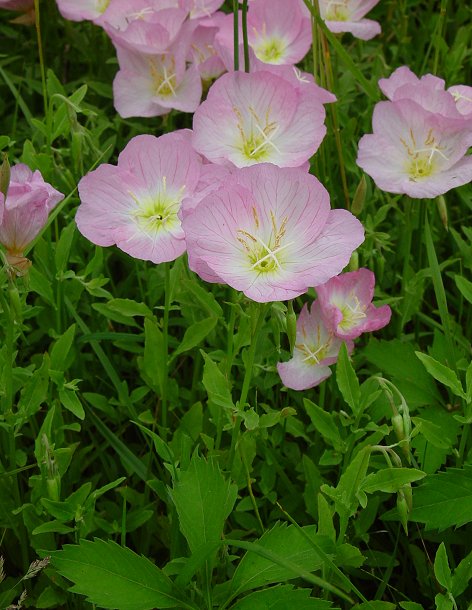Oenothera speciosa Nutt.
White Evening Primrose

Native
CC = 2
CW = 5
MOC = 47
© DETenaglia
Oenothera speciosa Nutt.White Evening Primrose | |
 |
Native CC = 2 CW = 5 MOC = 47 |
© DETenaglia |
|
Family - Onagraceae Stems - To 50cm tall, herbaceous, simple, glabrous to pubescent, erect or spreading, from taproot, typically multiple from base.
Leaves - Alternate, sessile to very short-petiolate, to 10cm long, 4cm broad, dentate-serrate to pinnatifid, variable in shape from linear to obovate, pubescent.
Inflorescence - Single flowers upper leaf axils, often nodding before anthesis. Pedicels typically antrorse strigose, subtended by pair of linear-subulate bracts. Flowers - Corolla pinkish to whitish, to 6cm broad. Petals 4, to 4cm long, +3cm broad, broadly obovate, emarginate to obtuse at apex, yellowish at base, mostly distinct but joined at base into short tube. Stamens 8, adnate at base of corolla. Filaments pale yellow to typically white, +1cm long, filiform, glabrous. Anthers yellow, to 7mm long. Style to +2.5cm long, filiform, greenish near base, whitish at apex. Stigma 4 lobed, (the lobes spreading). Ovary inferior. Floral tube to +1cm long, antrorse strigose. Sepals 4, sharply reflexed to one side, Typically connate and free at apex for 1-2mm, glabrous, often with reddish margins, yellow-green, to +2cm long, +/-3mm broad at base, lanceolate to subulate.
Flowering - May - July. Habitat - Waste ground, disturbed sites, fields, slopes, open woods, roadsides, railroads. Origin - Native to the U.S. Other info. - This and other species of Oenothera typically flower in the pre-dawn hours and the flowers only stay open until hot direct sun hits them. Photographs taken in Vale, NC., 5-11-03 (DETenaglia); also in St. Louis, 8-2-2023 (KBildner). |